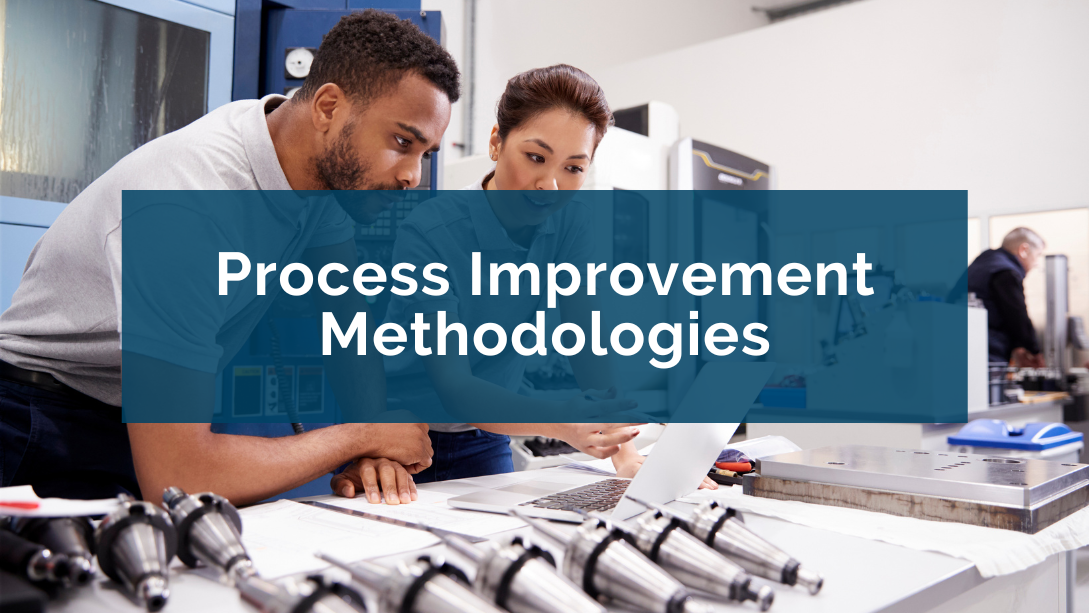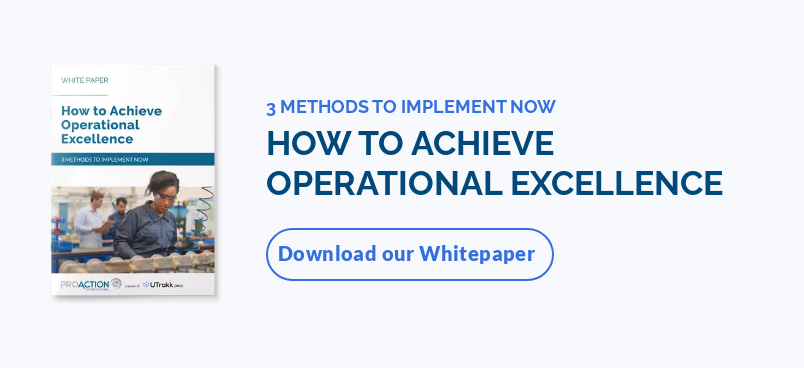What are process improvement methodologies?
A process improvement methodology implements a structured framework for analyzing and optimizing an organization's internal operations. Many techniques and tools are available to reach this operational goal. Some of them, such as Kaizen, SMED, JIT, and other process improvement methods are part of Lean Manufacturing, a philosophy focused on eliminating waste and improving operational efficiency.
But process improvement methodologies are not one-off solutions to be used once in a while. They must be part of a continuous improvement culture and applied consistently to integrate progressive or radical improvements within production systems.
Let's take the Kaizen method as an example:
In a car manufacturing plant, employees have to walk several meters to get the parts needed to assemble the vehicles. This creates waiting times and slows production without adding value to the final product.
By using the Kaizen method, the plant holds a series of meetings with employees working on the assembly line. They identify sources of waste, including the constant movement required to get the parts. They come up with a solution: reorganizing the workspace by moving assembly components closer to reduce unnecessary movement.
After implementing this solution, assembly times are reduced, employees are less tired, and overall plant productivity increases.
Benefits of improving business processes
- Increased productivity: Improving processes means faster task completion, so teams can concentrate on higher value-added activities. As machines and people become more efficient, overall productivity increases significantly.
- Reduced inefficiencies: By reviewing and adjusting processes, manufacturing companies can identify and eliminate redundant tasks and sources of waste. This improves workflow and makes operations more seamless.
- Increased quality: By optimizing every stage of the production process, errors and defects are minimized, ensuring that products or services consistently meet expected quality standards.
- Reduced costs: Redundant tasks, wastes, and errors lead to additional costs. By optimizing resource use and making operations more seamless, organizations reduce operational expenses.
- Improved customer satisfaction: By offering products or services of consistent quality and delivered on time, process improvement contributes to meeting customer demands, which strengthens trust and loyalty.
- Adaptability and agility: With optimized processes, a company is better able to adapt to regulations and opportunities, such as implementing advanced technologies, complying to regulatory changes, or meeting evolving customer expectations.
- Competitive advantage: Organizations that continuously improve their processes are better positioned in the marketplace. They become more competitive by offering timely delivery of higher-quality products or services.
16 Best process improvement methodologies to improve productivity
1. Lean Manufacturing
The Lean methodology is based on reducing or even eliminating waste (muda). By identifying and eliminating all non-value-added activities, Lean improves efficiency while focusing on customer satisfaction.
Primary objective: Maximize customer value by eliminating sources of waste that could slow down efficiency.
Use cases:
- Environments where reducing waste is essential to improving profitability.
- Manufacturing or production industries that seek to improve their efficiency without increasing their resources.
2. Six Sigma
Six Sigma is an analytical method for reducing process variation and eliminating defects, guaranteeing consistent quality.
Primary objective: Achieve near-perfect quality by minimizing errors and variations.
Use cases:
- Companies with recurring quality or variability problems in production.
- Organizations with complex processes that require a rigorous data-driven approach to improvement.
3. DMAIC
DMAIC is a systematic approach derived from Six Sigma. It is structured in five stages – Define, Measure, Analyze, Improve, Control – and designed to efficiently solve problems.
Primary objective: Analyze and improve processes based on measurable data.
Use cases:
- Organizations that seek to solve complex problems through data analysis.
- Companies that seek to improve existing processes in a structured way that guarantees lasting results.

4. Kaizen
Originating in Japan, Kaizen works with Lean Manufacturing and is focused on continuous improvement in small steps. It involves floor employees as well as management teams.
Primary objective: Improve processes progressively, day after day.
Use case:
- Companies that wish to establish a culture of continuous improvement and actively involve teams in optimizing processes.
5. Total Quality Management (TQM)
TQM is a continuous improvement process that aims to improve quality in every aspect of the company.
Primary objective: Ensure total quality in all company activities.
Use cases:
- Organizations that seek to place quality at the center of their organizational culture.
- Highly regulated industries where quality must be assured at all levels (e.g., pharmaceutical, food and beverage, etc.).
6. PDCA
The PDCA cycle is a simple and effective methodology including four stages – Plan, Do, Check, Act. It facilitates testing and implementation of process improvements.
Primary objective: Promote structured continuous improvement through testing and refinement.
Use cases:
- Companies that wish to test improvements on a small scale before rolling them out globally.

7. Business Process Management (BPM)
BPM aims to manage, monitor, and improve business processes systematically and progressively.
Primary objective: Improve process efficiency while ensuring greater transparency and adaptability to change.
Use cases:
- Organizations that need to automate and monitor their business processes in real time.
- Companies that seek to centralize process management, and ensure continuous improvement and close performance monitoring.
8. Just-in-Time (JIT)
JIT means producing only what is needed, when it is needed, in the quantity needed.
Primary objective: Reduce waste associated with excessive inventories and optimize responsiveness to demand.
Use cases:
- Companies wishing to reduce storage and inventory costs.
- Industries where demand is predictable and stable, enabling production based on actual orders (e.g., automotive, electronics, etc.).
9. Kanban
Inspired by the Toyota Production System, Kanban is a visual method for managing production flows. It uses physical or digital cards to manage tasks.
Primary objective: Optimize workflows and ensure the right resources are used at the right time.
Use cases:
- Environments where workflows are constantly changing (e.g., software development teams, continuous flow production lines, etc.).
- Companies looking to improve inventory and resource management.

10. Root cause analysis
Root cause analysis is used to identify the root cause of a problem to solve it for good. This approach uncovers the factors that contribute to a problem rather than the symptoms.
Primary objective: Eliminate the root cause of a problem to prevent its recurrence.
Use case:
- Companies that seek to avoid temporary solutions and ensure that problems are resolved permanently.
11. Agile
The Agile methodology is a flexible, iterative approach to managing and developing projects in small steps (sprints), with continuous adjustments based on feedback from users or customers.
Primary objective: Increase responsiveness to changing customer needs by fostering continuous improvement and communication.
Use cases:
- Complex or long projects where requirements can change rapidly (e.g., software development, technology innovation, etc.).
- Environments where interdisciplinary collaboration, adaptability, and flexibility are essential.
12. Single-Minute Exchange of Die (SMED)
The SMED method dramatically reduces tool or format changeover times on production lines.
Primary objective: Minimize downtime to increase flexibility and maximize production.
Use cases:
- Industrial companies where frequent format changes slow down production (e.g., printing, automotive, etc.).
- Environments where downtime directly affects productivity.
13. Value analysis
This tool assesses each step in a process to determine whether it adds value for the customer.
Primary objective: Maximize value by eliminating non-value-added activities.
Use cases:
- Companies that wish to refocus on high-value-added activities and eliminate inefficiencies.
- Strategic optimization phases for a product or service.
14. Value Stream Mapping (VSM)
This Lean tool provides an overview of all the stages involved in a production process, from the arrival of raw materials to the delivery of the final product.
Primary objective: Identify bottlenecks and non-value-added activities to streamline workflows.
Use cases:
- Companies that need to have an overview of their processes to identify improvement opportunities.
- Lean audits or improvement phases.
15. Poka-Yoke
Poka-Yoke is a human error prevention technique that involves designing mechanisms to prevent errors before they occur.
Primary objective: Minimize human error and guarantee product or service quality.
Use cases:
- Organizations where repetitive errors lead to additional costs or quality problems.
- Companies that wish to prevent mistakes before they occur, specifically in the industrial and mass-production sectors.
16. Ishikawa diagram (fishbone diagram)
This tool maps the possible causes of a problem by placing them in different categories.
Primary objective: To identify the root causes of a problem to find appropriate and effective solutions.
Use case:
- Teams that wish to solve complex problems requiring the analysis of multiple factors.
Steps to successfully implement a process improvement methodology

1. Identify the problem
Identify weaknesses or sticking points in your current processes. This can be done through process improvement metrics, direct observation of processes on the shop floor, employee feedback, or customer reviews.
For example, if a production line is experiencing frequent delays, the problem may be related to supply interruptions or machine downtime.
Pro tip: Involve all stakeholders to get a complete picture of the problem.
How UTrakk supports this step
- Centralization and real-time capture of process data in operational dashboards, enabling immediate analysis of trends and variances.
- Active supervision rituals to regularly observe work processes and gather feedback from teams directly on the shop floor, for a clear and objective understanding of problems.
2. Map the process
Once the problem has been identified, map the process to understand each step and how they flow. This will give you better visibility on sticking points or non-value-added tasks.
To visualize the workflow, use tools like Value Stream Mapping (VSM) or SIPOC diagram (Suppliers, Inputs, Processes, Outputs, Customers).
3. Set improvement goals
Define clear, specific, and measurable (SMART) objectives focused on the expected improvement results – for example, reduce production cycle time by 20% within three months, or reduce the error rate by 10% by the end of the quarter.
This step provides teams with a clear direction to guide their improvement efforts.
How UTrakk supports this step
- Features enabling easy integration and tracking of key performance indicators (KPIs).
- Real-time visualization of trends via intuitive dashboards, for better adjustment of objectives and greater responsiveness to improvement needs.
4. Develop solutions and choose the appropriate improvement method
Brainstorm with the teams executing the process to find solutions to the problems. At this stage, involving people with practical experience of the process helps define solutions that align with the realities of the shop floor.
Once you've outlined possible solutions, it's time to choose the process improvement methodology that will enable you to achieve your objectives. The chosen method will depend on the company's needs, the resources available, and the type of process to optimize.
For example, the Six Sigma methodology will be more appropriate if the objective is to reduce the variability of process results. If you want to improve overall task organization, Lean tools would be good choices.
How UTrakk supports this step
- Features for planning recurring meetings such as continuous improvement committees, production meetings, etc., enabling teams from different levels to work together to develop effective solutions.
- Tools to support the implementation of process improvement methodologies, including rituals, dashboards, and action plan tracking.
5. Implement changes
Implement the solution and methodology, and plan the process improvement project carefully to minimize disruption of operations.
Start by implementing process improvements as a pilot project, in a small area of your operations, before rolling it out globally, to see the impact of these changes.
Pro tip: This step can be upsetting for workers accustomed to their routine. Consider the manager's role in change management and give them the tools needed to train their teams and clearly communicate the objective of the change. This will facilitate buy-in from all people involved.
How UTrakk supports this step
- Project management features to create and track process improvement plans, including specific tasks, owners, and deadlines.
- Track process improvement projects using Gantt charts to monitor the progress of daily activities.
6. Monitor and adjust
After implementing the solution, track progress of key performance indicators defined at step 3. This will allow you to assess the effectiveness of the process improvements, accelerate problem-solving, and adjust solutions as necessary.
How UTrakk supports this step
- Real-time monitoring of KPIs via dashboards, providing precise analysis and reports to measure the impact of solutions.
- Features to update actions or objectives, and involve stakeholders in required adjustments or changes.
7. Sustain improvements
Improvements must be maintained over time to avoid going back to inefficient processes. This involves defining work standards, regularly training employees, and setting up ongoing monitoring mechanisms like 5S audits or other regular process evaluations.
How UTrakk supports this step
- KPI tracking included in several platform functionalities, for greater visibility and continuous monitoring of results.
- Periodic rituals such as audits and checks to ensure compliance with practices and encourage continuous improvement.
Sustaining long-term process improvement success
Achieving process excellence is one thing, but maintaining it over time is quite another. Improvement efforts must be continuous because it's over time that they'll bear fruit and make a real difference. Each process improvement methodology explored in this article can make your operations more efficient, smoother, and profitable. But without a monitoring and continuous improvement strategy, these gains fade very quickly.
The real challenge is to make process improvement a habit and a daily practice. So, you need a structured method to ensure consistency, embed continuous improvement initiatives in the company culture, and then reinforce it with a tool like UTrakk DMS. Combining technology, proven process improvement methodologies, and human involvement will enable your plant to maintain its competitive edge and ensure future process performance.
FAQ on process improvement methodologies










